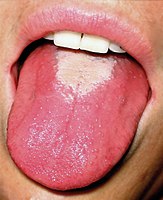
Photo from wikipedia
Tonsils form the topographically first immune barrier of an organism against the invasion of pathogens. We used histology to study the development of tonsils of pigs after birth. At birth,… Click to show full abstract
Tonsils form the topographically first immune barrier of an organism against the invasion of pathogens. We used histology to study the development of tonsils of pigs after birth. At birth, the tonsils consist of diffuse lymphoid tissue without any lymphoid follicle aggregations. At the age of 7 days, lymphoid follicles appeared in the soft palate tonsil. The lymphoid layer of the nasopharyngeal tonsil, soft palate tonsil, and lingual tonsil became thicker, and lymphoid follicles in the lamina propria were clearly visible at the age of 21 days. Secondary lymphoid follicles were present in the nasopharyngeal tonsil at the age of 50 days, and in the soft palate tonsil at the age of 120 days. Dendritic cells (DCs), CD3+ T cells and IgA+ B cells in the soft palate tonsil, nasopharyngeal tonsil and lingual tonsil increased continuously, especially during the first 21 days. The results suggested that tonsils have an important role in local immune defense against invading antigens after birth and will be beneficial for understanding the mechanisms of immunity in these animals after nasal and oral vaccination.
Journal Title: Journal of Morphology
Year Published: 2018
Link to full text (if available)
Share on Social Media: Sign Up to like & get
recommendations!